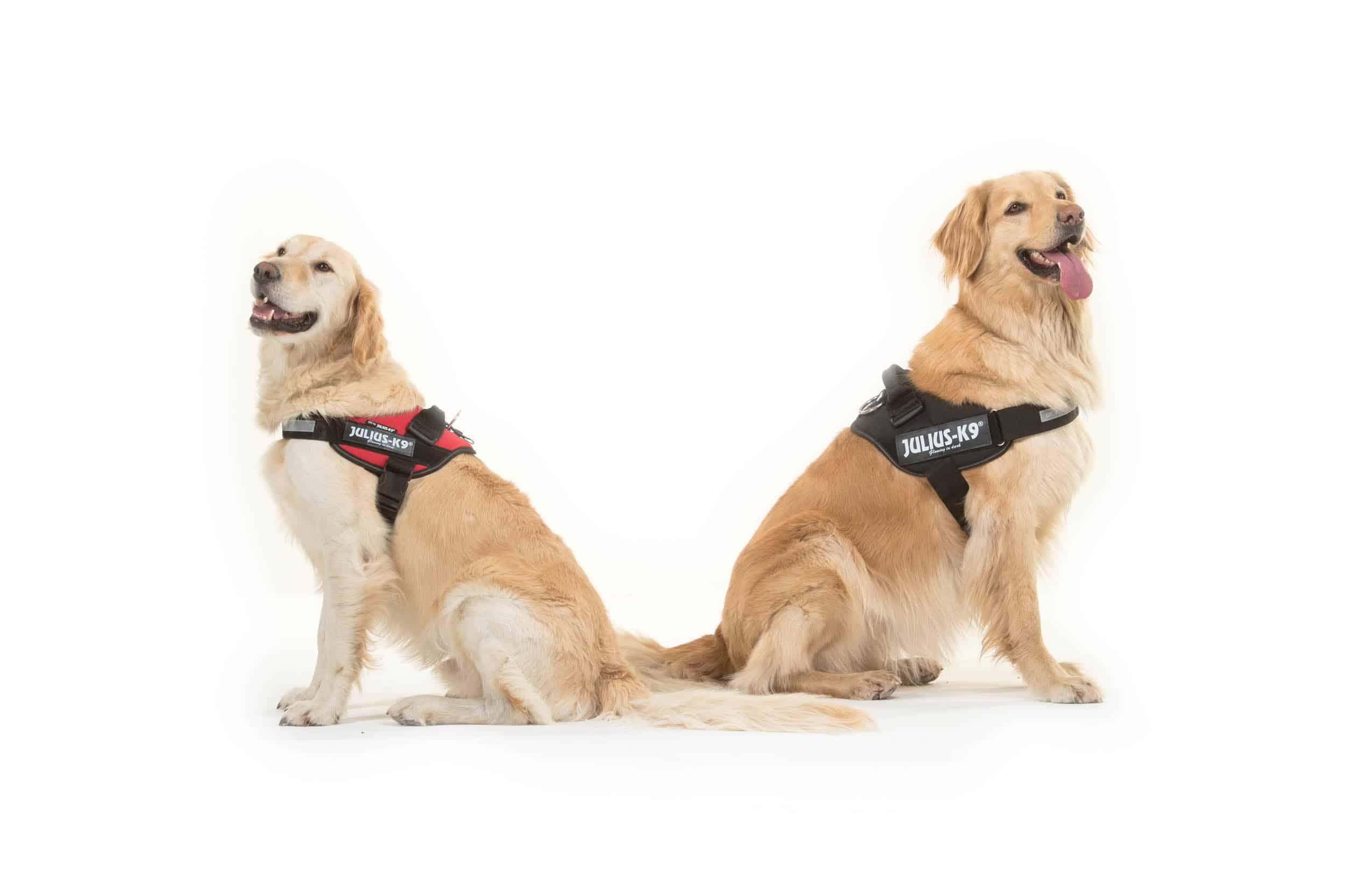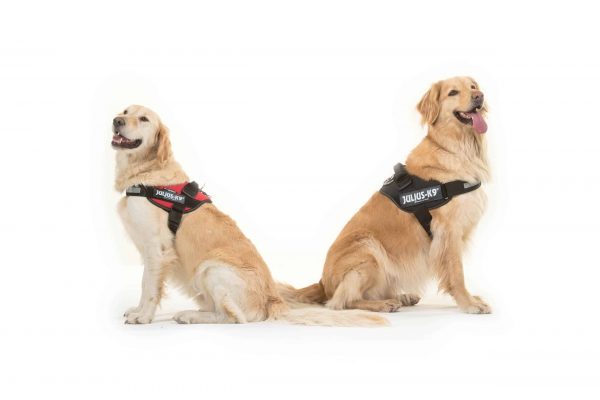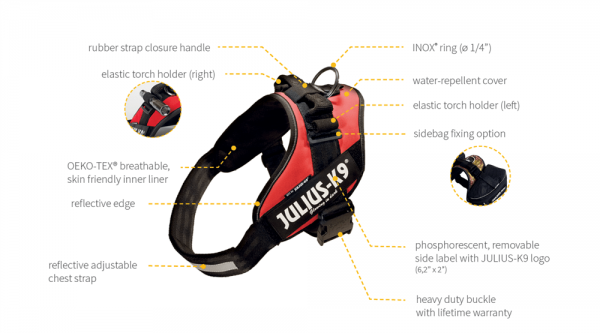
While dog collars can be very stylish and are certainly great for holding your pooch’s ID tag, replacing your furry friend’s collar with a harness like the Julius-K9 IDC Dog Power Harness is often a much better, safer solution. Here is why.
Reasons to Replace Your Dog’s Collar with a Harness
There are six very good reasons why harnesses are preferable to collars. The first three of these reasons essentially focus on the control you have over your furry friend and his & others’ safety:
#1 – Improved Control
 Dogs can be very different in temperament and some dogs love having fun so much, they are anything but little angels when walking on a lead. Displaying downright rowdy behaviour, these ever-active dogs may, for example, enjoy diving at unsuspecting birds, lunging at other dogs or chasing neighbours’ kittens – leaving their owners trying to keep them under control and out of trouble by pulling on their neck.
Dogs can be very different in temperament and some dogs love having fun so much, they are anything but little angels when walking on a lead. Displaying downright rowdy behaviour, these ever-active dogs may, for example, enjoy diving at unsuspecting birds, lunging at other dogs or chasing neighbours’ kittens – leaving their owners trying to keep them under control and out of trouble by pulling on their neck.
Enabling owners to direct their furry companion’s entire body (rather than steering him by the neck) a harness, on the other hand, offers much greater lead control. This can be especially important when walking a large, exuberant dog in a park or other busy area where he will be extra excited.
#2 – Reduced Pulling
Incessant lead pulling can make even short walks feel like a never-ending, hard-to-bear chore. Leaving their owners struggling to keep up and almost pulling their arms out of their sockets in the process (while still making forward progress), dogs that get away with pulling think doing so is the way to success – getting what they want when they want it.
Redirecting the dog’s momentum and hauling him into the opposite direction to where he wants to go, a harness discourages pulling by teaching the dog that pulling has no rewards – it will get him nowhere.
#3 – Reduced Risk of Escape
The rule of thumb for fitting a collar is that to ensure a comfortable, not-too-tight fit (which could hurt the dog), it should be possible to comfortably fit two fingers (adult-sized) between the dog’s body and the collar. Unfortunately, some canine escape artists (especially extra ‘wiggly’ dogs and dogs with small heads and thick necks) quickly learn to manoeuvre their collars up and over their heads.
Leaving them free to go sprinting down the road, this obviously poses potentially serious safety issues. Securely fitted around a dog’s chest, shoulders and front legs, a harness makes it impossible for canine ‘Houdinis’ to escape.
Using a harness is, however, about more than control – it is about preventing your dog from injuring himself:
#4 – Reduced Neck Strain
Lead pulling when wearing a collar places immense strain onto your furry friend’s neck. This can all too easily result in potentially serious injuries – injuries that are not so much of ‘a sudden pain’ but gradual deterioration and therefore not always immediately obvious.
Excited and far too busy focussing on what they are doing, dogs don’t even realise that they are hurting themselves and may instead begin showing subtle signs of discomfort – which may well turn out to be early symptoms of serious problems.
Small breeds like, for instance, Miniature Pinschers and Chihuahuas, have extremely delicate bones in the neck. This means they are particularly susceptible to neck injuries and a single, sharp pull on the lead can cause them a great deal of pain.
Dispersing the strain of pulling across a larger portion of a dog’s body, harnesses protect dogs against such injuries.
#5 – Reduced Risk of Ocular Proptosis
Ocular proptosis is a dangerous, painful condition manifested by dogs’ eyeballs protruding out of their sockets. Easy to diagnose due to it literally looking like the affected dog’s eyeballs are bulging out of his head and beyond his eyelids, this condition is typically the result of blunt head trauma.
For some breeds, however, excessive neck strain can also be responsible. Some brachiocephalic dog breeds (like, for example, Lhasa Apso, Shih Tzu, Pugs and Pekingese) have shallow orbits, which means they are predisposed to suffer this condition. In many cases, collars and the excessive strain they put on the animal’s neck are to blame for dogs developing ocular proptosis.
Reducing neck strain by dispersing it across the dog’s body, harnesses are an easy, effective way of protecting dogs against this condition.
#6 – Neck Injuries & Respiratory Problems
Any strain on a dog’s neck can be painful, but the risk is even higher if there is an existing neck injury or respiratory problem. Squeezing his windpipe, extra pressure around his neck can make it difficult for him to breathe. Being led by their collars results in many dogs having coughing fits.
Another chronic disease wearing a collar can make worse is tracheal collapse. Usually happening in smaller dog breeds where the cartilage making up the trachea is malformed or weakened, this condition causes restriction of the airways. Harnesses prevent this by keeping pressure of these dogs’ sensitive necks.
 Why the Julius-K9 IDC Dog Power Harness?
Why the Julius-K9 IDC Dog Power Harness?
Naturally, it is important to choose the most appropriate harness for your furry companion. Available in a range of sizes and featuring continuously adjustable tummy & chest straps to ensure a secure and comfortable fit for dogs of any size and shape, the Julius-K9 IDC Dog Power Harness is the perfect choice.
Providing optimal comfort with a skin-friendly & breathable Ökotex lining and even force distribution, the Julius-K9 Power Harness features a:
- Reflective chest-strap and edging for extra safety
- Crash-tested heavy-duty buckle
- INOX® stainless steel ring for lead attachment
- Back-handle grip to enable short term lifting/holding of dogs (please note that this is not available with sizes Baby 1 & Baby 2)
More comfortable than conventional collars, safe and secure, the Power Harness also comes with an extensive range of optional attachments and accessories – making it the ideal choice not only for daily walking with your pet, but for working dogs, sports and high-impact activities (i.e. rough terrain walking, etc.)
